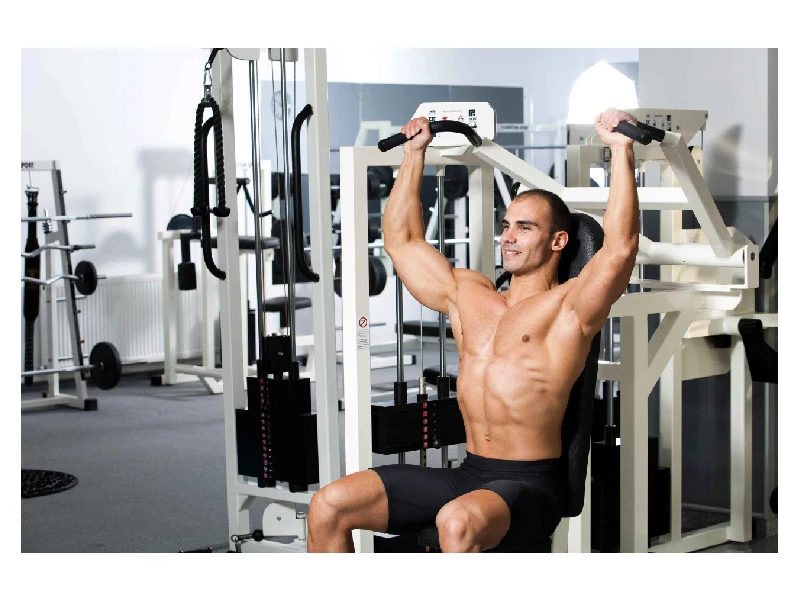
Want broader, stronger shoulders that command attention? The shoulder press is one of the most effective upper-body exercises to achieve just that. It’s a timeless movement used by athletes, bodybuilders, and fitness enthusiasts to build muscle, enhance posture, and increase upper-body strength.
In this comprehensive guide, you’ll discover everything you need to know about the shoulder press — from proper technique and variations to tips for maximizing results and avoiding injury.
What Is the Shoulder Press?
The shoulder press, also known as the overhead press or military press, is a compound exercise that targets multiple upper-body muscles simultaneously. It primarily strengthens your deltoids (shoulders) but also engages your triceps, upper chest, and core.
A Brief History
The shoulder press dates back to the early 20th century when weightlifters considered it the ultimate test of upper-body power. Before the bench press became popular, lifters often used the standing barbell press to demonstrate strength and stability.
Muscle Groups Worked
The shoulder press is a multi-joint movement that recruits several muscle groups:
-
Primary Muscles: Anterior and lateral deltoids
-
Secondary Muscles: Triceps brachii, trapezius, serratus anterior, upper pectorals
-
Stabilizers: Core, lower back, and glutes (especially during standing presses)
| Variation | Primary Muscles | Secondary Muscles | Difficulty Level |
|---|---|---|---|
| Barbell Shoulder Press | Front delts | Triceps, traps | High |
| Dumbbell Shoulder Press | Front & side delts | Core, triceps | Medium |
| Machine Shoulder Press | Front delts | Triceps | Low |
| Arnold Press | All deltoid heads | Triceps, upper chest | High |
Benefits of the Shoulder Press
The shoulder press isn’t just for bodybuilders — it benefits anyone looking to improve posture, balance, and overall upper-body power.
1. Builds Strong, Balanced Shoulders
This exercise develops all parts of the deltoid muscle, leading to rounder and more defined shoulders. It also prevents muscular imbalances caused by overtraining the chest.
2. Improves Core and Postural Stability
During a standing shoulder press, your abs and lower back work to stabilize your torso. Over time, this leads to better posture and core endurance.
3. Boosts Athletic Performance
Athletes rely on shoulder strength for explosive movements — whether it’s shooting a basketball, throwing a punch, or swimming. Shoulder presses improve power output and overhead mobility.
4. Enhances Everyday Functional Strength
From lifting boxes to reaching overhead shelves, the shoulder press mimics real-life movements that strengthen your ability to perform daily tasks effortlessly.
How to Perform the Shoulder Press Correctly
Proper form is critical for maximizing gains and preventing injury. Follow these steps for a perfect shoulder press:
Step-by-Step Guide
-
Start Position: Stand tall with feet shoulder-width apart. Hold dumbbells or a barbell at shoulder height.
-
Grip: Keep your palms facing forward and elbows slightly in front of your body.
-
Press: Push the weights overhead until your arms are fully extended but not locked.
-
Lower: Slowly bring the weights back to shoulder height in a controlled motion.
-
Repeat: Maintain steady breathing and form throughout each rep.
Pro Tip: Avoid arching your lower back — tighten your abs to protect your spine.
Common Mistakes to Avoid
-
Overarching the lower back
-
Using momentum instead of muscle power
-
Lowering weights too quickly
-
Not bringing the bar/dumbbells to the correct shoulder level
-
Using too heavy weights before mastering form
Shoulder Press Variations to Build Power
Mixing up your shoulder press variations keeps your workouts fresh and targets muscles from different angles.
1. Barbell Shoulder Press
-
Best for heavy lifting and progressive overload
-
Builds raw strength and mass
-
Requires more stability and core engagement
2. Dumbbell Shoulder Press
-
Improves coordination and balance
-
Reduces muscle imbalances between sides
-
Allows for a greater range of motion
3. Arnold Press
Named after Arnold Schwarzenegger, this variation rotates the wrists during movement to hit all three deltoid heads. It’s excellent for shaping and defining your shoulders.
4. Seated Shoulder Press
-
Focuses more on shoulder isolation
-
Minimizes lower-body involvement
-
Great for controlled, muscle-focused reps
5. Machine Shoulder Press
-
Ideal for beginners or rehabilitation
-
Provides guided motion for safety
-
Allows controlled overload without worrying about balance
Standing Shoulder Press vs. Seated Shoulder Press
| Feature | Standing Press | Seated Press |
|---|---|---|
| Core Engagement | High | Low |
| Shoulder Isolation | Moderate | High |
| Balance Challenge | Yes | Minimal |
| Ideal For | Functional strength | Hypertrophy focus |
Tip: Alternate between both to enjoy the best of strength and muscle growth.
Best Equipment for Shoulder Press Workouts
You don’t need fancy equipment to perform a shoulder press. Here are common tools you can use:
-
Dumbbells: Great for home workouts and muscle balance
-
Barbell: Best for building mass and strength
-
Smith Machine: Offers safety and control
-
Resistance Bands: Portable and perfect for beginners
-
Kettlebells: Adds an element of instability to engage stabilizers
Programming Shoulder Press into Your Routine
The right reps, sets, and frequency depend on your goals. Use the guide below:
| Goal | Sets | Reps | Rest Period |
|---|---|---|---|
| Strength | 4–6 | 4–6 | 2–3 minutes |
| Muscle Growth (Hypertrophy) | 3–4 | 8–12 | 60–90 seconds |
| Endurance | 2–3 | 12–15 | 30–60 seconds |
Training Frequency
For optimal results:
-
Perform shoulder press 1–2 times per week.
-
Allow 48 hours of recovery between workouts.
-
Combine with lateral raises, upright rows, and rear delt flyes for a complete shoulder routine.
Safety Tips and Injury Prevention
Your shoulder joints are complex and delicate, so caution is key.
-
Warm up with shoulder rotations and band pull-aparts.
-
Strengthen rotator cuff muscles regularly.
-
Keep your wrists straight and aligned with your forearms.
-
Don’t lock elbows at the top of the press.
-
Always control the descent phase.
Quote: “Perfect form builds perfect strength.” — Anonymous Trainer
Alternatives to the Shoulder Press
Want to mix things up? These alternatives challenge your muscles in new ways:
-
Push Press: Adds leg drive for more power output.
-
Handstand Push-Up: A bodyweight powerhouse for strength.
-
Landmine Press: Safer for those with limited shoulder mobility.
-
Kettlebell Press: Engages stabilizers for joint health and balance.
Frequently Asked Questions About the Shoulder Press
Is the shoulder press good for beginners?
Yes. Start with a machine shoulder press or light dumbbells to learn proper form.
Can I do shoulder press every day?
No. Shoulders need time to recover. Overtraining can lead to joint strain or injury.
Should I do shoulder press standing or seated?
It depends on your goal. Standing presses build full-body stability while seated presses focus purely on shoulder isolation.
Final Thoughts — Master the Shoulder Press for Stronger Shoulders
The shoulder press is more than just an exercise; it’s a benchmark of upper-body power and balance. Whether you’re pressing a barbell in the gym or dumbbells at home, the key lies in consistency, proper form, and progressive overload.
By adding this movement to your training routine, you’ll not only sculpt impressive shoulders but also develop strength that carries into your daily life. Remember lift smart, stay patient, and your results will speak for themselves.


